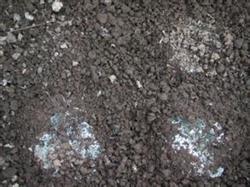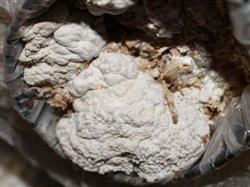Pleurotus ostreatus cultivation should be strictly controlled seed production

Mother → original seed purchase test tube mother, we should pay attention to identify the advantages and disadvantages of the mother, carefully check the mycelium growth in the test tube, in order to avoid buying the aging mother. Generally speaking, the strong mother species are white, stout and neat at the tip of the hyphae. If the mycelium is dry or the culture medium shrinks, there is yellow stagnant water at the bottom of the bottle, indicating that the mycelium is aging, please do not buy it. It is the first time that the strain is expanded and cultured from the mother species to the original species. Specific methods: material preparation: test tube mother seed, beer bottle (according to the dosage of 1 test tube mother seed inoculated with 12 beer bottles), corn kernels or wheat kernels (according to the dosage of 250g corn kernels or wheat kernels in one beer bottle), etc. Operation process: first deal with the culture material, if you choose wheat kernels, you need to soak them in water for 24 hours (change water for 3 times in the middle to prevent acidification); if you choose corn kernels, because their seed coat is thick and not easy to soak, you need to cook them and use them. Note that when cooking corn kernels, we should grasp the heat, neither let the corn kernels "blossom", nor can they be ripe and endogenous. When the amount of culture material in the beer bottle is 4 beat 5 of that of the bottle, it is sealed with a cotton plug and wrapped with Kraft paper to prevent steam soaking the cotton plug during high temperature sterilization. Then put the bottle on the steamer and sterilize at high temperature for about 12 hours. After sterilization, wait for the bottle temperature to drop to 30 ℃, then transfer it to the aseptic inoculation box for inoculation, that is, pick up a little hyphae from the parent test tube with a vaccination needle, quickly put it into the beer bottle, seal it with cotton plugs, and wrap it with Kraft paper. Then, the inoculated beer bottles were stored in a room with a temperature of about 25 ℃ to promote mycelium growth. It usually takes 20 to 25 days to get the original seed. Reminder: a good original mycelium is dense, white, uniform, stout, cotton-wool-like, and has the phenomenon of climbing the wall. After the original species grows full of bottles, it is necessary to expand and propagate into cultivated species immediately, otherwise once the nutrients are exhausted, the hyphae will grow old and even die. The original → first-class cultivated species is the cultivated species when the original seed is expanded and propagated. However, due to the small number of original species, if directly transferred to the mushroom bag for mushroom production, not only because of the small number of bacteria and weak bacteria, but also lead to uneven mushroom production due to the inconsistent growth rate at both ends of the bag. Therefore, it is suggested that mushroom farmers should adopt the seed production mode of first small bag and then large bag, that is, the original seed is inoculated into small bag for seed production, and then transferred to large bag for formal cultivation, so as to ensure sufficient bacterial growth speed and uniformity, and strong bacterial potential, and the probability of infection of miscellaneous bacteria is small. Material preparation: first-class cotton seed shell (wet with water until the fingers are wet without dripping, add appropriate amount of lime to adjust pH and stir evenly); small bacterial bags (polyethylene plastic bags with specifications of 18 cm × 40 cm × 0.03 cm or 22 cm × 45 cm × 0.04 cm, etc.). Operation process: first put the prepared culture material cotton seed shell into a small bacterial bag, tie both ends tightly, and then put it on the steamer for high temperature sterilization. When the temperature reaches 100 ℃, it lasts for 20 hours. After sterilization, put it in a cool and ventilated place to cool down. When the temperature is below 30 ℃, it can be inoculated. In order to facilitate vaccination, you can use an inoculation spoon to pour all the original seeds in the beer bottle into a small basin, or first wrap tape around the beer bottle, then break the bottle, remove the broken glass, and put the original seed into a small basin for use. When inoculating, use the inoculation spoon to put the original seed into the two ends of the small bacteria bag. Finally, the inoculated small bacteria bag should be placed in a place where the temperature is relatively constant. Generally, the mycelium can grow full of the whole bag in about 20 days. Reminder: when placing the inoculated small bacterial bag, we should pay attention to the residual heat in the bacterial bag, and the hyphae will produce a lot of heat in the growth. Therefore, it should not be stacked too high, generally stacked in the shape of "well" in the shape of 3 to 4 layers, in order to facilitate ventilation and heat dissipation and avoid "burning bacteria". In addition, the primary cultivated species should often turn the bag in the process of culture to prevent heat accumulation, and at the same time check the mycelium growth and whether there is infection and so on. Generally, the bag should be turned 3 times in the whole culture process. After the mycelium grows full, it needs to be transferred to the large bacterial bag immediately, otherwise it is easy to cause mycelium aging and reduce its production efficiency. At present, the primary cultivated species → secondary cultivated species are mainly cultivated with raw materials, and the culture materials are mainly cottonseed hulls, and appropriate amounts of corncob, wheat bran, lime or gypsum, sugar or corn flour, trace elements and inorganic salts are added to make the nutrition comprehensive and balanced. Due to the cultivation of raw materials, the culture materials should be sterilized before use. Methods: when the culture material was mixed with water, mix it with sodium dichloroisocyanurate, mix it with 500 kg culture material every 0.5 kg, and then cover it with plastic film for about 12 hours. Finally, the culture material can be packed in a large bacterial bag. It should be noted that the method of "four-layer bacteria and three-layer material" should be used for sub-packing and sowing in order to speed up the speed of bacteria and improve the effect of mushroom production. According to this method, a small bag of cultivated species can be divided into 2 or 3 large bacterial bags.
- Prev

Causes of abnormal fruiting body of Pleurotus ostreatus
1. Fruiting body primordium differentiation is not good, similar to cauliflower. The main reasons are poor ventilation and high carbon dioxide concentration in the fruiting room. 2. The fruiting body cap is small and shriveled, and the stipe is long and hard. The main causes are high temperature, low humidity and poor ventilation. 3. Young mushrooms have slender stems and small pileus. Form...
- Next

How to cultivate fragrant wood? Culture methods and matters needing attention of fragrant wood
The fragrant wood is a plant of the genus Coptis in the lacquer family. It is resistant to drought and barren, developed roots and strong resistance. It is a pioneer tree species for afforestation in the dry-hot valley, and it is also the main fuel wood in this area. The fragrant wood has a beautiful shape and a fragrant smell. It has a variety of edible and medicinal functions, and has a broad development prospect.
Related
- Fuxing push coffee new agricultural production and marketing class: lack of small-scale processing plants
- Jujube rice field leisure farm deep ploughing Yilan for five years to create a space for organic food and play
- Nongyu Farm-A trial of organic papaya for brave women with advanced technology
- Four points for attention in the prevention and control of diseases and insect pests of edible fungi
- How to add nutrient solution to Edible Fungi
- Is there any good way to control edible fungus mites?
- Open Inoculation Technology of Edible Fungi
- Is there any clever way to use fertilizer for edible fungus in winter?
- What agents are used to kill the pathogens of edible fungi in the mushroom shed?
- Rapid drying of Edible Fungi

